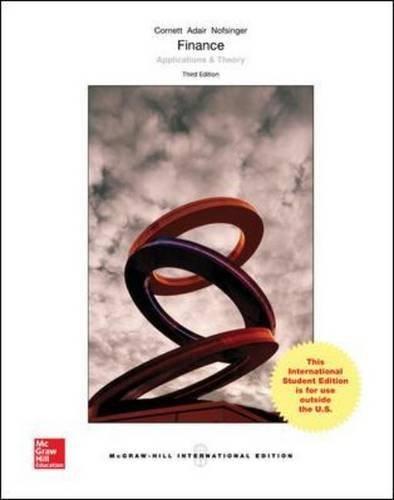Question
P3-1. You have $1,500 to invest today at 7 percent interest compounded annually. a) How much will you have accumulated in the account at the
P3-1. You have $1,500 to invest today at 7 percent interest compounded annually.
a) How much will you have accumulated in the account at the end of the following number of years?
1. three years
2. six years
3. nine years
b. Use your findings in part (a) to calculate the amount of interest earned in
1. years 1 to 3
2. years 4 to 6
3. years 7 to 9
c. Compare and contrast your findings in part (b). Explain why the amount of interest earned increases in each succeeding three-year period
P3-3. You just won a lottery that promises to pay you $1 million exactly ten years from today. Because the $1 million payment is guaranteed by the state in which you live, opportunities exist to sell the claim today for an immediate lump-sum cash payment.
a. What is the least you will sell your claim for if you could earn the following rates of return on similar risk investments during the ten-year period?
1. 6 percent
2. 9 percent
3. 12 percent
b. Rework part (a) under the assumption that the $1 million payment will be received in fifteen rather than ten years.
c. Based on your findings in parts (a) and (b), discuss the effect of both the size of the rate of return and the time until receipt of payment on the present value of a future sum.
P3-7. Gina Coulson has just contracted to sell a small parcel of land that she inherited a few years ago. The buyer is willing to pay $24,000 at the closing of the transaction or will pay the amounts, shown in the following table, at the beginning of each of the next five years. Because Gina doesnt really need the money today, she plans to let it accumulate in an account that
earns 7 percent annual interest. Given her desire to buy a house at the end of five years after closing on the sale of the lot, she decides to choose the payment alternative$24,000 lump sum or the mixed stream of payments in the following tablethat provides the highest future value at the end of five years.
Mixed Stream
| Beginning of Year (t) | Cash Flow (C F t ) |
1 $ 2,000
2 4,000
3 6,000
4 8,000
5 10,000
P3-11. As part of your personal budgeting process, you have determined that in each of the next fi ve years you will have budget shortfalls. In other words, you need the amounts shown in the following table at the end of the given year to balance your budget, that is, to make inflows equal outflows. You expect to be able to earn 8 percent on your investments during the next five years and want to fund the budget shortfalls over these years with a
Single initial deposit.
End of Year Budget Shortfall
1 $ 5,000
2 4,000
3 6,000
4 10,000
5 3,000
P3-16. Use the following table of cash flows to answer parts (a)(c). Assume an 8 percent discount rate.
End of Year Cash Flow
1 $10,000
2 10,000
3 10,000
4 12,000
5 12,000
6 12,000
7 12,000
8 15,000
9 15,000
10 15,000
a. Solve for the present value of the cash flow stream by summing the present value of each individual cash flow.
b. Solve for the present value by summing the present value of the three separate annuities (one current and two deferred).
c. Which method is better for a long series of cash flows with embedded annuities?
P3-22. Jason Spector has shopped around for the best interest rates for his investment of $10,000 over the next year. He has found the following:
Stated Rate Compounding
6 10% annual
5 90% semiannual
5 85% monthly
a. Which investment offers Jason the highest effective annual rate of return?
b. Assume that Jason wants to invest his money for only six months, and the annual compounded rate of 6.10 percent is not available. Which of the remaining opportunities should Jason choose?
P3-32. You are planning to purchase a motorhome for $40,000, and you have $10,000 to apply as a down payment. You may borrow the remainder under the following terms: a ten-year loan with semiannual repayments and a stated interest rate of 6 percent. You intend to make $6,000 payments, applying the excess over your required payment to the reduction of the principal balance.
a. Given these terms, how long (in years) will it take you to fully repay your loan?
b. What will be your total interest cost?
c. What would be your interest cost if you made no prepayments and repaid your loan by strictly adhering to the terms of the loan?
Step by Step Solution
There are 3 Steps involved in it
Step: 1

Get Instant Access to Expert-Tailored Solutions
See step-by-step solutions with expert insights and AI powered tools for academic success
Step: 2

Step: 3

Ace Your Homework with AI
Get the answers you need in no time with our AI-driven, step-by-step assistance
Get Started


